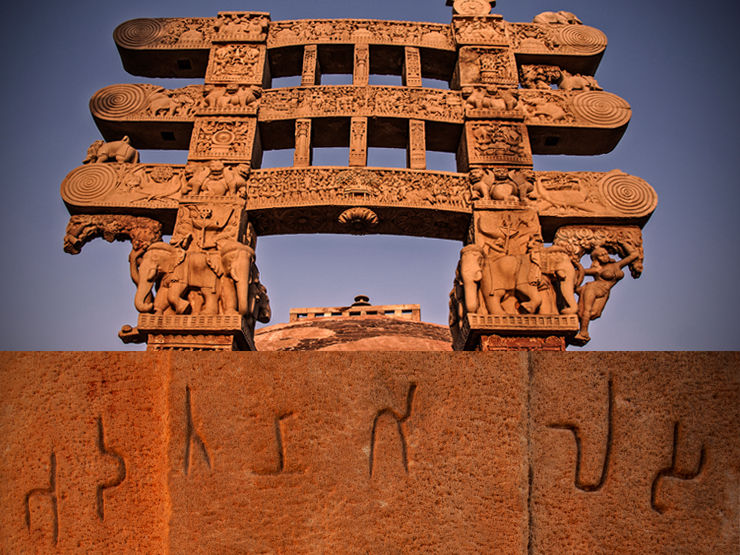Udaygiri Caves
- Ashok Parab

- Oct 16, 2022
- 3 min read
Updated: Oct 16, 2022
The Historical Hathigumpha Inscription.
Udaygiri caves are located near the city of Bhubaneswar in state of Odisha, India. These caves were excavated in the 1st Century B.C. by King Kharavela.
Referred to as the Hills of Sunrise or Sunrise Hills, the Udayagiri Caves are partly natural and partly artificial caves in Odisha. Excavated by King Kharavela and his successors in 1st century B. C., the site saw activities till the time of Somavamshis (A. D. 10th - 11th century). Today these caves situated near the city of Bhubaneswar are of archaeological, historical and religious importance.

The caves of Udayagiri called ‘lena or lea’ according to the inscriptions, were created as residences for Jain ascetics. The most common structure seen is row of cells that open to the veranda or to the open space. Later quarters were converted into shrines, excavated further and changes were made to the height and depth of the chambers. One can see 18 caves in Udayagiri. The important caves include:
Hathi Gumpha
Ananta Gumpha
Ganesha Gumpha
Jaya Vijaya Gumpha
Mancapuri Gumpha
Bagha / Yaghra / Vyaghra Gumpha
Sarpa Gumpha
The Rani Gumpha or the Queen’s Cave is the largest, most majestic cave among all.
Rani Gumpha or Cave of the Queen
Rani (Queen) Gumpha, a double-storeyed structure is considered the largest and most popular cave among the cluster at Udayagiri. It gains its importance due to some fine examples of ancient beautiful sculptures.

Each storey has three wings with the central wing being the largest. One can find seven entrances in the lower floor in the middle wing. The upper floor with nine columns contains relief images illustrating a king’s victory march. The pilasters have the ‘toranas’ (arches) with sculptures of royal scenes and Jain religious importance. Other sculptures are now disfigured ‘Dwarpalas’ , scenes from forests with animals and trees.
Ganesha Gumpha
Among other caves of significance is the Ganesh Gumpha, with a carved figure of Lord Ganesh on the back of its right cell. Supposed to be carved later and not among the original works, the cave has two large statues of elephants carrying garlands at the entrance. It is a 1st example of sculpture of animals shown to guard an entrance. Along with carved figures of ‘Dwarpalas’ the other carvings of this cave depict the story of the elopement of Bassavadatta, Princess of Ujjayini, with King Udayana of Kausambi accompanied by Vasantaka.
Vyaghra Gumpha
Vyaghra Gumpha a popular cave, but in ruins, is named after the prominent carving at the entrance - a tiger's mouth. A single cell forms the tiger's throat. The word ‘vyaghra’ means ‘tiger’ and according to the inscription studied, this cave belonged to the city judge Sabhuti.
Hathi Gumpha Inscription
The inscription is often studied for its historic and linguistic value and provides information about the reign of King Kharavela of the 1st century B.C. Kalinga.
The Hathi Gumpha has become a sacred destination for epigraphists, historians as well as archeologists after the inscription was discovered by the historian. A Sterling after the British conquest of Orissa at the beginning of the 19th century. Hathi means an Elephant. The inscription is often studied for its historic and linguistic value and provides information about the reign of King Kharavela of the 1st century B.C. Kalinga. The Elephant Cave inscription speaks of the glories of the king and at the beginning of the text is the sacred Jain chant - Namokar Mantra. The king is described as ‘The worshipper of all religious orders, the repairer of all shrines of gods’. The Hathi Gumpha Inscription, written in the Kavya Style, is a seventeen line inscription in Prakrit language incised in Brahmi script. Inscribed by the Jain king Kharavela of Kalinga kingdom, it is dated between 2nd century BCE and 1st century CE. It records the life of the king until his 38th year and they include 13 years of his reign. This inscription is of significance as it gives a great insight into the ancient history of Kharavela and it is one of the few notable inscriptions which throw much light on ancient Indian history especially of the glorious period of the Kalinga in relation to the political,
socio-economical and cultural conditions. It also portrays Kharavela as a king not only as a conqueror but also a patron of culture and a promoter of Jainism. The Inscription also includes the religious values, public infrastructure projects, military expeditions and their purpose.

On conducting a hand writing analysis, it was found that three different scribes were likely to have worked together on this inscription. Today the inscription is damaged significantly by elements of nature with only 4 lines from the original 17lines intact. Even today though in ruins, the Hathi Gumpha is a valuable piece of epigraphic evidence that shares information on Nanda, Maurya, Mahameghavahan dynasties, shows images of contemporary North and South India and tells the tale of foreign invading the Yavans.

Comments